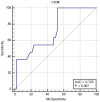Dynamic Changes in Lymphocyte Populations and Their Relationship with Disease Severity and Outcome in COVID-19
- PMID: 39595989
- PMCID: PMC11593669
- DOI: 10.3390/ijms252211921
Dynamic Changes in Lymphocyte Populations and Their Relationship with Disease Severity and Outcome in COVID-19
Abstract
Studies suggest that the dynamic changes in cellular response might correlate with disease severity and outcomes in SARS-CoV-2 patients. The study aimed to investigate the dynamic changes of lymphocyte subsets in patients with COVID-19. In this regard, 53 patients with COVID-19 were prospectively included, classified as mild, moderate, and severe. The peripheral lymphocyte profiles (LyT, LyB, and NK cells), as well as CD4+/CD8+, CD3+/CD19+, CD3+/NK and CD19+/NK ratios, and their dynamic changes during hospitalization and correlation with disease severity and outcome were assessed. We found significant differences in CD3+ lymphocytes between severity groups (p < 0.0001), with significantly decreased CD3+CD4+ and CD3+CD8+ in patients with severe disease (p < 0.0001 and p = 0.048, respectively). Lower CD3+/CD19+ and CD3+/NK ratios among patients with severe disease (p = 0.019 and p = 0.010, respectively) were found. The dynamic changes of lymphocyte subsets showed a significant reduction in NK cells (%) and a significant increase in CD3+CD4+ and CD3+CD8+ cells in patients with moderate and severe disease. The ROC analysis on the relationship between CD3+ cells and fatal outcome yielded an AUC of 0.723 (95% CI 0.583-0.837; p = 0.007), while after addition of age and SpO2, ferritin and NLR, the AUC significantly improved to 0.927 (95%CI 0.811-0.983), p < 0.001 with a sensitivity of 90.9% (95% CI 58.7-99.8%) and specificity of 85.7% (95% CI 69.7-95.2%). The absolute number of CD3+ lymphocytes might independently predict fatal outcomes in COVID-19 patients and T-lymphocyte subset evaluation in high-risk patients might be useful in estimating disease progression.
Keywords: COVID-19; SARS-CoV-2; dynamic changes; lymphocyte profiles; outcome.
Conflict of interest statement
The authors declare no conflicts of interest.
Figures







Similar articles
-
Alterations in B and NK cells highly correlate with disease severity in children with COVID-19.Turk J Med Sci. 2023 Aug 10;53(5):1205-1213. doi: 10.55730/1300-0144.5686. eCollection 2023. Turk J Med Sci. 2023. PMID: 38813014 Free PMC article.
-
Lymphocyte Subset Alteration and Monocyte CD4 Expression Reduction in Patients with Severe COVID-19.Viral Immunol. 2021 Jun;34(5):342-351. doi: 10.1089/vim.2020.0166. Epub 2020 Nov 23. Viral Immunol. 2021. PMID: 33264073
-
CD4 and CD8 Lymphocyte Counts as Surrogate Early Markers for Progression in SARS-CoV-2 Pneumonia: A Prospective Study.Viruses. 2020 Nov 9;12(11):1277. doi: 10.3390/v12111277. Viruses. 2020. PMID: 33182268 Free PMC article.
-
The role of cytokine profile and lymphocyte subsets in the severity of coronavirus disease 2019 (COVID-19): A systematic review and meta-analysis.Life Sci. 2020 Oct 1;258:118167. doi: 10.1016/j.lfs.2020.118167. Epub 2020 Jul 29. Life Sci. 2020. PMID: 32735885 Free PMC article.
-
A systematic meta-analysis of immune signatures in patients with COVID-19.Rev Med Virol. 2021 Jul;31(4):e2195. doi: 10.1002/rmv.2195. Epub 2020 Nov 20. Rev Med Virol. 2021. PMID: 34260780 Free PMC article.
Cited by
-
Breakthrough Tick-Borne Encephalitis and Epidemiological Trends in an Endemic Region in Poland: A Retrospective Hospital-Based Study, 1988-2020.Vaccines (Basel). 2025 Jun 20;13(7):665. doi: 10.3390/vaccines13070665. Vaccines (Basel). 2025. PMID: 40733642 Free PMC article.
References
-
- COVID-19 Deaths|WHO COVID-19 Dashboard. [(accessed on 19 August 2024)]. Available online: https://data.who.int/dashboards/covid19/deaths.
-
- Briciu V., Topan A., Calin M., Dobrota R., Leucuta D.-C., Lupse M. Comparison of COVID-19 Severity in Vaccinated and Unvaccinated Patients during the Delta and Omicron Wave of the Pandemic in a Romanian Tertiary Infectious Diseases Hospital. Healthcare. 2023;11:373. doi: 10.3390/healthcare11030373. - DOI - PMC - PubMed
MeSH terms
Grants and funding
LinkOut - more resources
Full Text Sources
Medical
Research Materials
Miscellaneous

